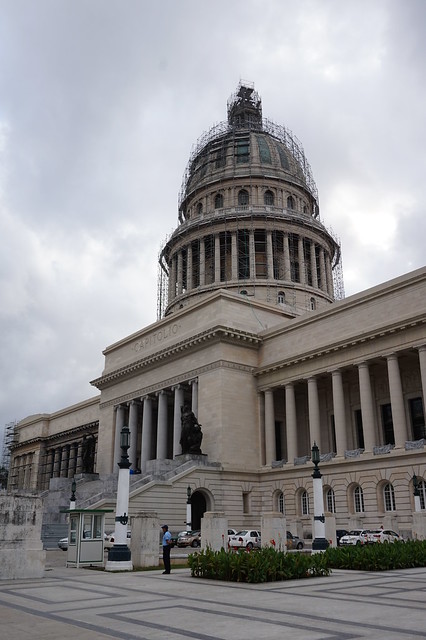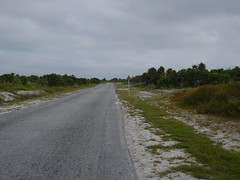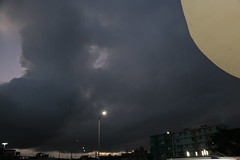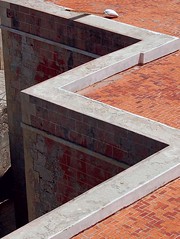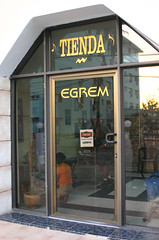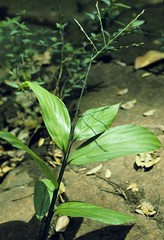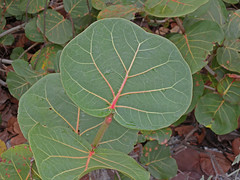 Cuba
Cuba
Cuba (English: /ˈkbə/ , Spanish: [ˈkuβa];), officially the Republic of Cuba (Spanish: República de Cuba Spanish: [reˈpuβlika ðe ˈkuβa]), is an island country comprising the island of Cuba, as well as Isla de la Juventud and several minor archipelagos. Cuba is located where the northern Caribbean Sea, Gulf of Mexico, and Atlantic Ocean meet. Cuba is located east of the Yucatán Peninsula (Mexico), south of both the American state of Florida and the Bahamas, west of Hispaniola (Haiti/Dominican Republic), and north of both Jamaica and the Cayman Islands. Havana is the largest city and capital; other major cities include Santiago de Cuba and Camagüey. The official area of the Republic of Cuba is (without the territorial waters) but a total of including the exclusive economic zone. Cuba is the second-most populous country in the Caribbean after Haiti, with over 11 million inhabitants.
The territory that is now Cuba was inhabited by the Ciboney people from the 4th millennium BC with the Guanahatabey and Taíno peoples until Spanish colonization in the 15th century. From the 15th century, it was a colony of Spain, and slavery was abolished in 1886, remaining a Spanish colony until the Spanish–American War of 1898, when Cuba was occupied by the United States and gained independence in 1902. In 1940, Cuba implemented a new constitution, but mounting political unrest culminated in a coup in 1952 and the subsequent dictatorship of Fulgencio Batista, which was later overthrown in January 1959 by the 26th of July Movement during the Cuban Revolution, which afterwards established communist rule under the leadership of Fidel Castro. The country was a point of contention during the Cold War between the Soviet Union and the United States, and a nuclear war nearly broke out during the Cuban Missile Crisis of 1962. Following the collapse of the Soviet Union, Cuba faced a severe economic downturn in the 1990s, known as the Special Period. In 2008, Fidel Castro resigned after 49 years of leadership of Cuba and was replaced by his brother Raúl Castro.
Cuba is one of a few extant Marxist–Leninist one-party socialist states, in which the role of the vanguard Communist Party is enshrined in the Constitution. Cuba has an authoritarian regime where political opposition is not permitted. Censorship of information (including limits to Internet access) is extensive, and independent journalism is repressed in Cuba; Reporters Without Borders has characterized Cuba as one of the worst countries in the world for press freedom.
Culturally, Cuba is considered part of Latin America. It is a multiethnic country whose people, culture and customs derive from diverse origins, including the Taíno Ciboney peoples, the long period of Spanish colonialism, the introduction of enslaved Africans and a close relationship with the Soviet Union in the Cold War.
Cuba is a founding member of the United Nations, G77, Non-Aligned Movement, Organisation of African, Caribbean and Pacific States, ALBA, and Organization of American States. It has currently one of the world's few planned economies, and its economy is dominated by the tourism industry and the exports of skilled labor, sugar, tobacco, and coffee. Cuba has historically—both before and during communist rule—performed better than other countries in the region on several socioeconomic indicators, such as literacy, infant mortality and life expectancy.
Etymology
Historians believe the name Cuba comes from the Taíno language, however "its exact derivation is unknown". The exact meaning of the name is unclear but it may be translated either as 'where fertile land is abundant' (cubao), or 'great place' (coabana).
Fringe theory writers who believe that Christopher Columbus was Portuguese state that Cuba was named by Columbus for the town of Cuba in the district of Beja in Portugal.
History
Pre-Columbian era
The Caribbean ground sloths, one of the last survivors of the pleistocene megafauna, lived in Cuba possibly until 2660 BCE.
Before the arrival of the Spanish, Cuba was inhabited by two distinct tribes of indigenous peoples of the Americas: the Taíno (including the Ciboney people), and the Guanahatabey.
The ancestors of the Taíno migrated from the mainland of South America, with the earliest sites dated to 5,000 BP.
The Taíno arrived from Hispaniola sometime in the 3rd century A.D. When Columbus arrived, they were the dominant culture in Cuba, having an estimated population of 150,000. It is unknown when or how the Guanahatabey arrived in Cuba, having both a different language and culture than the Taíno; it is inferred that they were a relict population of pre-Taíno settlers of the Greater Antilles.
The Taíno were farmers, as well as fishers and hunter-gatherers.
Spanish colonization and rule (1492–1898)
After first landing on an island then called Guanahani, Bahamas, on 12 October 1492, Christopher Columbus commanded his three ships: La Pinta, La Niña and the Santa María, discovering Cuba on 27 October 1492, and landing in the northeastern coast on 28 October. (This was near what is now Bariay, Holguín Province) Columbus claimed the island for the new Kingdom of Spain and named it Isla Juana after John, Prince of Asturias.
In 1511, the first Spanish settlement was founded by Diego Velázquez de Cuéllar at Baracoa. Other settlements soon followed, including San Cristobal de la Habana, founded in 1515, which later became the capital. The indigenous Taíno were forced to work under the encomienda system, which resembled the feudal system in medieval Europe. Within a century, the indigenous people were virtually wiped out due to multiple factors, primarily Eurasian infectious diseases, to which they had no natural resistance (immunity), aggravated by the harsh conditions of the repressive colonial subjugation. In 1529, a measles outbreak in Cuba killed two-thirds of those few natives who had previously survived smallpox.
On 18 May 1539, conquistador Hernando de Soto departed from Havana with some 600 followers into a vast expedition through the American Southeast, starting in Florida, in search of gold, treasure, fame and power. On 1 September 1548, Gonzalo Perez de Angulo was appointed governor of Cuba. He arrived in Santiago, Cuba, on 4 November 1549, and immediately declared the liberty of all natives. He became Cuba's first permanent governor to reside in Havana instead of Santiago, and he built Havana's first church made of masonry.
By 1570, most residents of Cuba comprised a mixture of Spanish, African, and Taíno heritages. Cuba developed slowly and, unlike the plantation islands of the Caribbean, had a diversified agriculture. Most importantly, the colony developed as an urbanized society that primarily supported the Spanish colonial empire. By the mid-18th century, there were 50,000 slaves on the island, compared to 60,000 in Barbados and 300,000 in Virginia; as well as 450,000 in Saint-Domingue, all of which had large-scale sugarcane plantations.
The Seven Years' War, which erupted in 1754 across three continents, eventually arrived in the Spanish Caribbean. Spain's alliance with the French pitched them into direct conflict with the British, and in 1762, a British expedition consisting of dozens of ships and thousands of troops set out from Portsmouth to capture Cuba. The British arrived on 6 June, and by August, had placed Havana under siege. When Havana surrendered, the admiral of the British fleet, George Pocock and the commander of the land forces George Keppel, the 3rd Earl of Albemarle, entered the city, and took control of the western part of the island. The British immediately opened up trade with their North American and Caribbean colonies, causing a rapid transformation of Cuban society.
Though Havana, which had become the third-largest city in the Americas, was to enter an era of sustained development and increasing ties with North America during this period, the British occupation of the city proved short-lived. Pressure from London to sugar merchants, fearing a decline in sugar prices, forced negotiations with the Spanish over the captured territories. Less than a year after Britain captured Havana, it signed the 1763 Treaty of Paris together with France and Spain, ending the Seven Years' War. The treaty gave Britain Florida in exchange for Cuba. Cubans constituted one of the many diverse units which fought alongside Spanish forces during the conquest of British West Florida (1779–81).
The largest factor for the growth of Cuba's commerce in the late eighteenth and early nineteenth century was the Haitian Revolution. When the enslaved peoples of what had been the Caribbean's richest colony freed themselves through violent revolt, Cuban planters perceived the region's changing circumstances with both a sense of fear and opportunity. They were afraid because of the prospect that slaves might revolt in Cuba as well, and numerous prohibitions during the 1790s of the sale of slaves in Cuba who had previously been enslaved in French colonies underscored this anxiety. The planters saw opportunity, however, because they thought that they could exploit the situation by transforming Cuba into the slave society and sugar-producing "pearl of the Antilles" that Haiti had been before the revolution. As the historian Ada Ferrer has written, "At a basic level, liberation in Saint-Domingue helped entrench its denial in Cuba. As slavery and colonialism collapsed in the French colony, the Spanish island underwent transformations that were almost the mirror image of Haiti's." Estimates suggest that between 1790 and 1820 some 325,000 Africans were imported to Cuba as slaves, which was four times the amount that had arrived between 1760 and 1790.
Although a smaller proportion of the population of Cuba was enslaved, at times, slaves arose in revolt. In 1812, the Aponte Slave Rebellion took place, but it was ultimately suppressed. The population of Cuba in 1817 was 630,980 (of which 291,021 were white, 115,691 were free people of …
Looking for places related to Cuba?
Those are other destinations to find places related to Cuba:
